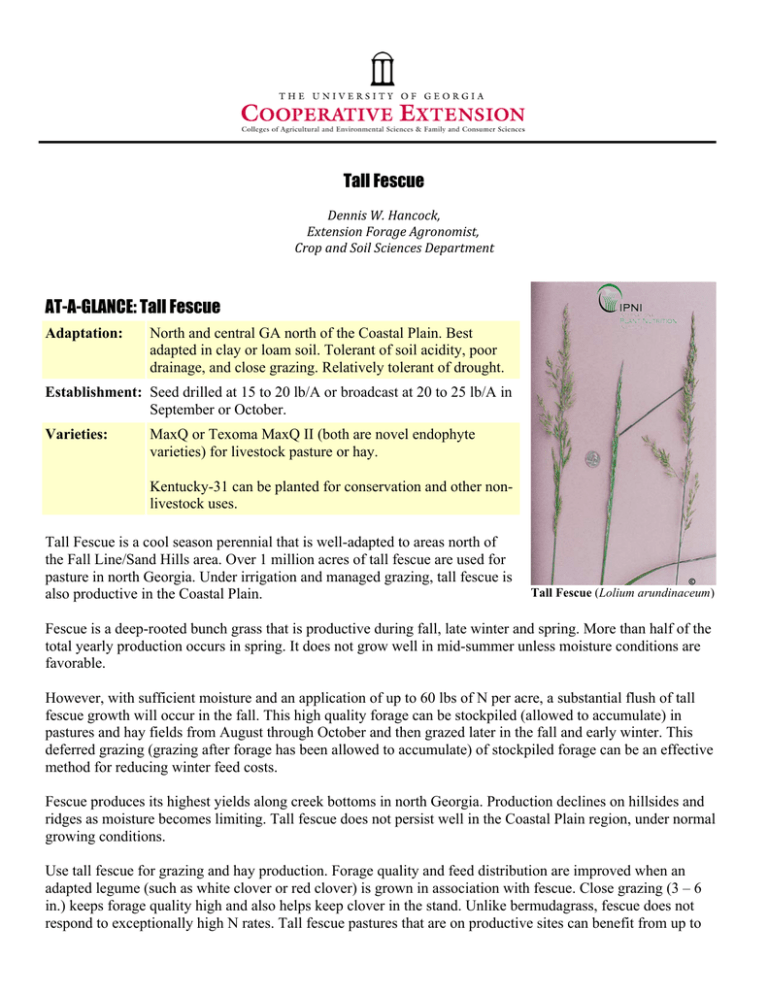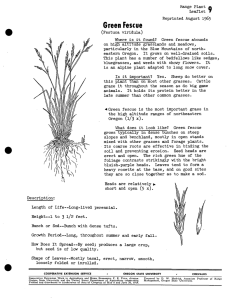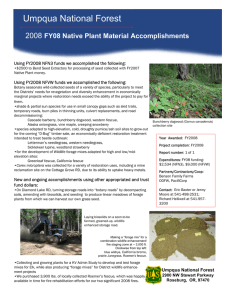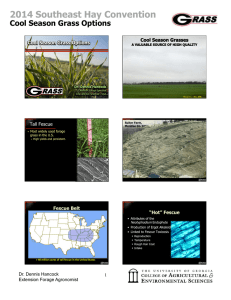Tall Fescue
advertisement

Tall Fescue ! "#$$%&!'(!)*$+,+-.! !!!!!!/01#$&%,$!2,3*4#!543,$,6%&1.! !!!!!!!73,8!*$9!:,%;!:+%#$+#&!"#8*316#$1! AT-A-GLANCE: Tall Fescue Adaptation: North and central GA north of the Coastal Plain. Best adapted in clay or loam soil. Tolerant of soil acidity, poor drainage, and close grazing. Relatively tolerant of drought. Establishment: Seed drilled at 15 to 20 lb/A or broadcast at 20 to 25 lb/A in September or October. Varieties: MaxQ or Texoma MaxQ II (both are novel endophyte varieties) for livestock pasture or hay. Kentucky-31 can be planted for conservation and other nonlivestock uses. Tall Fescue is a cool season perennial that is well-adapted to areas north of the Fall Line/Sand Hills area. Over 1 million acres of tall fescue are used for pasture in north Georgia. Under irrigation and managed grazing, tall fescue is also productive in the Coastal Plain. © Tall Fescue (Lolium arundinaceum) Fescue is a deep-rooted bunch grass that is productive during fall, late winter and spring. More than half of the total yearly production occurs in spring. It does not grow well in mid-summer unless moisture conditions are favorable. However, with sufficient moisture and an application of up to 60 lbs of N per acre, a substantial flush of tall fescue growth will occur in the fall. This high quality forage can be stockpiled (allowed to accumulate) in pastures and hay fields from August through October and then grazed later in the fall and early winter. This deferred grazing (grazing after forage has been allowed to accumulate) of stockpiled forage can be an effective method for reducing winter feed costs. Fescue produces its highest yields along creek bottoms in north Georgia. Production declines on hillsides and ridges as moisture becomes limiting. Tall fescue does not persist well in the Coastal Plain region, under normal growing conditions. Use tall fescue for grazing and hay production. Forage quality and feed distribution are improved when an adapted legume (such as white clover or red clover) is grown in association with fescue. Close grazing (3 – 6 in.) keeps forage quality high and also helps keep clover in the stand. Unlike bermudagrass, fescue does not respond to exceptionally high N rates. Tall fescue pastures that are on productive sites can benefit from up to 100 lbs of N per acre and support a high stocking rate. However, most fescue pastures in north Georgia are moderately stocked and are on marginal sites that will receive no benefit from N applications in excess of 50 lbs of N per acre. If clover comprises less than 15 percent of the stand, treat it as a grass stand. Reduce N rates to 20 to 30 pounds per acre if the stand contains 15-35% legumes. If the stand contains more than 35% legumes, no supplemental N is needed. Tall Fescue Toxicosis The vast majority of tall fescue that survives in pastures in Georgia is infected with a fungus that grows inside the plant and is transmitted in the seed. This fungus (Neotyphodium coenophialum) is called an endophyte. The wild- or native-type endophyte (E+) produces toxins called ergot-alkaloids. Livestock that consume E+ tall fescue may suffer reduced conception rates, decreased weight gain, decreased milk production, constricted blood flow (especially to extremities), slightly-elevated body temperature, heat intolerance (animals stand in the shade more than normal), excessive nervousness, and failure to shed winter hair coats in the spring. These problems are collectively referred to as “fescue toxicosis.” (See http://www.caes.uga.edu/commodities/ fieldcrops/forages/questions/fescuetoxicosis.html for more on fescue toxicosis). Endophyte-free (E-) varieties are sold and have been used in Georgia since the 1990s. Unfortunately, research has shown that E- varieties fail to persist well under less-than-ideal growing conditions. It was found that the endophyte imparts some very positive characteristics in the tall fescue plant that it infects (pest resistance, drought tolerance, persistence under grazing, etc.). As a result, E- tall fescue varieties are not recommended in Georgia. More recently, tall fescue varieties have become available that are infected with a “novel” or “friendly” endophyte (NE). This novel-endophyte imparts essentially all the positive agronomic characteristics of a wildtype endophyte, but without producing any of the ergot alkaloid toxins. Although the cost per lb of NE tall fescue is substantially greater than other tall fescue types, the investment is well worth it. Economists from UGA have closely examined this practice and have found that replacement of E+ tall fescue with NE tall fescue is a cost-effective strategy for nearly all forage-based livestock systems in Georgia. As a result, NE tall fescue is recommended for all new plantings of tall fescue pasture or hay. Additional Information More detailed information about tall fescue is available for the University of Georgia in the Extension Bulletin entitled “Tall Fescue Production and Utilization” and the more recent Extension Bulletin, “Novel EndophyteInfected Tall Fescue.” The University of Georgia and Ft. Valley State University, the U.S. Department of Agriculture and counties of the state cooperating. Cooperative Extension, the University of Georgia College of Agricultural and Environmental Sciences, offers educational programs, assistance and materials to all people without regard to race, color, national origin, age, gender or disability. ! "#!$%&'(!)**+,-&#.-/!$0*(+/1,2"33.,0'-.41!"5-.+#!),6'#.7'-.+#!8+00.--19!-+!'!:.41,;1!<+,=!>+,51! 8??@>ABC!!!!!!!!!!!!!!!!!!!!!!!!!!!!!!!!!!!!!!!!!!!!!!!!!!!!!!!!!!!!!!!!!!!!!!!!!!!!!!!!!!!!!!!!!!!!!!!!!!!!!!!!!!!!!!!!!!!!!!!!!!!!!!!!!!!!!!!!!!!!!!!!!!!!!!!!!!!!!!!!!!!!!!!!!!!! ! ! !!!!!!!D&(/!EABB! Issued in furtherance of Cooperative Extension work, Acts of May 8 and June 30, 1914, The University of Georgia College of Agricultural and Environmental Sciences and the U.S. Department of Agriculture cooperating. J. Scott Angle, Dean and Director.



